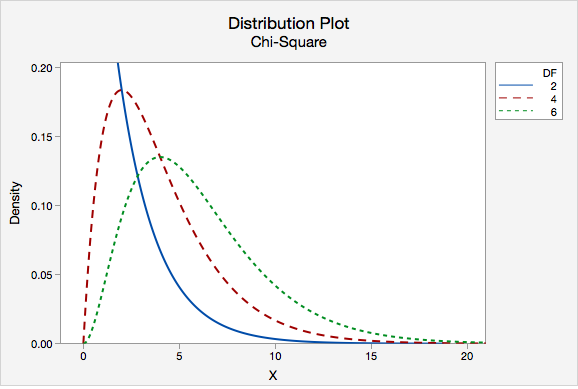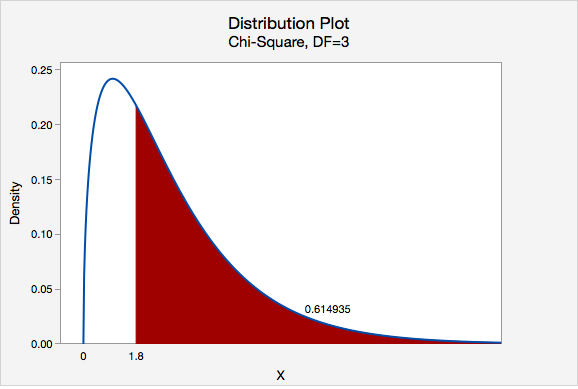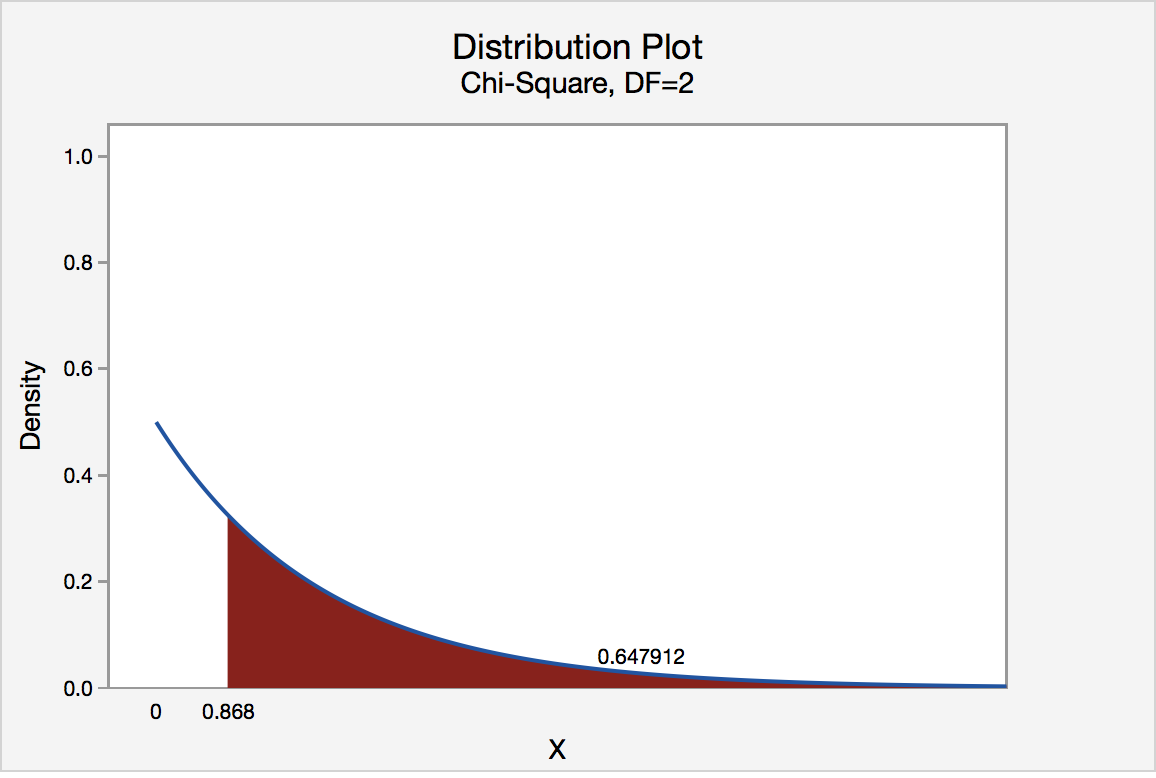11.2 - Goodness of Fit Test
11.2 - Goodness of Fit TestA chi-square goodness-of-fit test can be conducted when there is one categorical variable with more than two levels. If there are exactly two categories, then a one proportion z test may be conducted. The levels of that categorical variable must be mutually exclusive. In other words, each case must fit into one and only one category.
We can test that the proportions are all equal to one another or we can test any specific set of proportions.
If the expected counts, which we'll learn how to compute shortly, are all at least five, then the chi-square distribution may be used to approximate the sampling distribution. If any expected count is less than five, then a randomization test should be conducted.
- According to one research study, about 90% of American adults are right-handed, 9% are left-handed, and 1% are ambidextrous. Are the proportions of Penn State students who are right-handed, left-handed, and ambidextrous different from these national values?
- A concessions stand sells blue, red, purple, and green freezer pops. They survey a sample of children and ask which of the four colors is their favorite. They want to know if the colors differ in popularity.
Test Statistic
In conducting a goodness-of-fit test, we compare observed counts to expected counts. Observed counts are the number of cases in the sample in each group. Expected counts are computed given that the null hypothesis is true; this is the number of cases we would expect to see in each cell if the null hypothesis were true.
- Expected Cell Value
- \(E=n (p_i)\)
-
\(n\) is the total sample size
\(p_i\) is the hypothesized proportion of the "ith" group
The observed and expected values are then used to compute the chi-square (\(\chi^2\)) test statistic.
- Chi-Square (\(\chi^2\)) Test Statistic
-
\(\chi^2=\sum \dfrac{(Observed-Expected)^2}{Expected}\)
Approximating the Sampling Distribution
StatKey has the ability to conduct a randomization test for a goodness-of-fit test. There is an example of this in Section 7.1 of the Lock5 textbook. If all expected values are at least five, then the sampling distribution can be approximated using a chi-square distribution.
Like the t distribution, the chi-square distribution varies depending on the degrees of freedom. Degrees of freedom for a chi-square goodness-of-fit test are equal to the number of groups minus 1. The distribution plot below compares the chi-square distributions with 2, 4, and 6 degrees of freedom.

To find the p-value we find the area under the chi-square distribution to the right of our test statistic. A chi-square test is always right-tailed.
11.2.1 - Five Step Hypothesis Testing Procedure
11.2.1 - Five Step Hypothesis Testing ProcedureThe examples on the following pages use the five step hypothesis testing procedure outlined below. This is the same procedure that we used to conduct a hypothesis test for a single mean, single proportion, difference in two means, and difference in two proportions.
When conducting a chi-square goodness-of-fit test, it makes the most sense to write the hypotheses first. The hypotheses will depend on the research question. The null hypothesis will always contain the equalities and the alternative hypothesis will be that at least one population proportion is not as specified in the null.
In order to use the chi-square distribution to approximate the sampling distribution, all expected counts must be at least five.
Expected Count
\(E=np_i\)
Where \(n\) is the total sample size and \(p_i\) is the hypothesized population proportion in the "ith" group.
To check this assumption, compute all expected counts and confirm that each is at least five.
In Step 1 you already computed the expected counts. Use this formula to compute the chi-square test statistic:
Chi-Square Test Statistic
\(\chi^2=\sum \dfrac{(O-E)^2}{E}\)
Where \(O\) is the observed count for each cell and \(E\) is the expected count for each cell.
Construct a chi-square distribution with degrees of freedom equal to the number of groups minus one. The p-value is the area under that distribution to the right of the test statistic that was computed in Step 2. You can find this area by constructing a probability distribution plot in Minitab.
Unless otherwise stated, use the standard 0.05 alpha level.
\(p \leq \alpha\) reject the null hypothesis.
\(p > \alpha\) fail to reject the null hypothesis.
Go back to the original research question and address it directly. If you rejected the null hypothesis, then there is convincing evidence that at least one of the population proportions is not as stated in the null hypothesis. If you failed to reject the null hypothesis, then there is not enough evidence that any of the population proportions are different from what is stated in the null hypothesis.
11.2.1.1 - Video: Cupcakes (Equal Proportions)
11.2.1.1 - Video: Cupcakes (Equal Proportions)11.2.1.2- Cards (Equal Proportions)
11.2.1.2- Cards (Equal Proportions)Example: Cards
Research question: When randomly selecting a card from a deck with replacement, are we equally likely to select a heart, diamond, spade, and club?
I randomly selected a card from a standard deck 40 times with replacement. I pulled 13 hearts, 8 diamonds, 8 spades, and 11 clubs.
Let's use the five-step hypothesis testing procedure:
\(H_0: p_h=p_d=p_s=p_c=0.25\)
\(H_a:\) at least one \(p_i\) is not as specified in the null
We can use the null hypothesis to check the assumption that all expected counts are at least 5.
\(Expected\;count=n (p_i)\)
All \(p_i\) are 0.25. \(40(0.25)=10\), thus this assumption is met and we can approximate the sampling distribution using the chi-square distribution.
\(\chi^2=\sum \dfrac{(Observed-Expected)^2}{Expected} \)
All expected values are 10. Our observed values were 13, 8, 8, and 11.
\(\chi^2=\dfrac{(13-10)^2}{10}+\dfrac{(8-10)^2}{10}+\dfrac{(8-10)^2}{10}+\dfrac{(11-10)^2}{10}\)
\(\chi^2=\dfrac{9}{10}+\dfrac{4}{10}+\dfrac{4}{10}+\dfrac{1}{10}\)
\(\chi^2=1.8\)
Our sampling distribution will be a chi-square distribution.
\(df=k-1=4-1=3\)
We can find the p-value by constructing a chi-square distribution with 3 degrees of freedom to find the area to the right of \(\chi^2=1.8\)

The p-value is 0.614935
\(p>0.05\) therefore we fail to reject the null hypothesis.
There is not enough evidence to state that the proportion of hearts, diamonds, spades, and clubs that are randomly drawn from this deck are different.
11.2.1.3 - Roulette Wheel (Different Proportions)
11.2.1.3 - Roulette Wheel (Different Proportions)Example: Roulette Wheel
Research Question: An American roulette wheel contains 38 slots: 18 red, 18 black, and 2 green. A casino has purchased a new wheel and they want to know if there is convincing evidence that the wheel is unfair. They spin the wheel 100 times and it lands on red 44 times, black 49 times, and green 7 times.
If the wheel is fair then \(p_{red}=\dfrac{18}{38}\), \(p_{black}=\dfrac{18}{38}\), and \(p_{green}=\dfrac{2}{38}\).
All of these proportions combined equal 1.
\(H_0: p_{red}=\dfrac{18}{38},\;p_{black}=\dfrac{18}{38}\;and\;p_{green}=\dfrac{2}{38}\)
\(H_a: At\;least\;one\;p_i\;is \;not\;as\;specified\;in\;the\;null\)
In order to conduct a chi-square goodness of fit test all expected values must be at least 5.
For both red and black: \(Expected \;count=100(\dfrac{18}{38})=47.368\)
For green: \(Expected\;count=100(\dfrac{2}{38})=5.263\)
All expected counts are at least 5 so we can conduct a chi-square goodness of fit test.
\(\chi^2=\sum \dfrac{(Observed-Expected)^2}{Expected} \)
In the first step we computed the expected values for red and black to be 47.368 and for green to be 5.263.
\(\chi^2= \dfrac{(44-47.368)^2}{47.368}+\dfrac{(49-47.368)^2}{47.368}+\dfrac{(7-5.263)^2}{5.263} \)
\(\chi^2=0.239+0.056+0.573=0.868\)
Our sampling distribution will be a chi-square distribution.
\(df=k-1=3-1=2\)
We can find the p-value by constructing a chi-square distribution with 2 degrees of freedom to find the area to the right of \(\chi^2=0.868\)

The p-value is 0.647912
\(p>0.05\) therefore we should fail to reject the null hypothesis.
There is not enough evidence that this roulette wheel is unfair.
11.2.2 - Minitab: Goodness-of-Fit Test
11.2.2 - Minitab: Goodness-of-Fit TestExample: Cards
Research Question: When randomly selecting a card from a deck with replacement, are we equally likely to select a heart, diamond, spade, and club?
I randomly selected a card from a standard deck 40 times with replacement. I pulled 13 Hearts (♥), 8 Diamonds (♦), 8 Spades (♠), and 11 Clubs (♣).
Minitab® – Conducting a Chi-Square Goodness-of-Fit Test
Summarized Data, Equal Proportions
To perform a chi-square goodness-of-fit test in Minitab using summarized data we first need to enter the data into the worksheet. Below you can see that we have one column with the names of each group and one column with the observed counts for each group.
| C1 | C2 | |
|---|---|---|
| Suit | Count | |
| 1 | Hearts | 13 |
| 2 | Diamonds | 8 |
| 3 | Spades | 8 |
| 4 | Clubs | 11 |
- After entering the data, select Stat > Tables > Chi-Square Goodness of Fit Test (One Variable)
- Double-click Count to enter it into the Observed Counts box
- Double-click Suit to enter it into the Category names (optional) box
- Click OK
This should result in the following output:
Chi-Square Goodness-of-Fit Test: Count
Observed and Expected Counts
| Category | Observed | Test Proportion |
Expected | Contribution to Chi-Sq |
|---|---|---|---|---|
| Hearts | 13 | 0.25 | 10 | 0.9 |
| Diamonds | 8 | 0.25 | 10 | 0.4 |
| Spades | 8 | 0.25 | 10 | 0.4 |
| Clubs | 11 | 0.25 | 10 | 0.1 |
Chi-Square Test
| N | DF | Chi-Sq | P-Value |
|---|---|---|---|
| 40 | 3 | 1.8 | 0.615 |
All expected values are at least 5 so we can use the chi-square distribution to approximate the sampling distribution. Our results are \(\chi^2 (3) = 1.8\). \(p = 0.615\). Because our p-value is greater than the standard alpha level of 0.05, we fail to reject the null hypothesis. There is not enough evidence to conclude that the proportions are different in the population.
Note!
The example above tested equal population proportions. Minitab also has the ability to conduct a chi-square goodness-of-fit test when the hypothesized population proportions are not all equal. To do this, you can choose to test specified proportions or to use proportions based on historical counts.
11.2.2.1 - Example: Summarized Data, Equal Proportions
11.2.2.1 - Example: Summarized Data, Equal ProportionsExample: Tulips
A company selling tulip bulbs claims they have equal proportions of white, pink, and purple bulbs and that they fill customer orders by randomly selecting bulbs from the population of all of their bulbs.
You ordered 30 bulbs and received 16 white, 8 pink, and 6 purple.
Is there convincing evidence the bulbs you received were not randomly selected from a population with an equal proportion of each color?
Use Minitab to conduct a hypothesis test to address this research question.
We'll go through each of the steps in the hypotheses test:
\(H_0\colon p_{white}=p_{pink}=p_{purple}=\dfrac{1}{3}\)
\(H_a\colon\) at least one \(p_i\) is not \(\dfrac{1}{3}\)
We can use the null hypothesis to check the assumption that all expected counts are at least 5.
\(Expected\;count=n (p_i)\)
All \(p_i\) are \(\frac{1}{3}\). \(30(\frac{1}{3})=10\), thus this assumption is met and we can approximate the sampling distribution using the chi-square distribution.
Let's use Minitab to calculate this.
First, enter the summarized data into a Minitab Worksheet.
C1 | C2 | |
|---|---|---|
Color | Count | |
1 | White | 16 |
2 | Pink | 8 |
3 | Purple | 6 |
- After entering the data, select Stat > Tables > Chi-Square Goodness of Fit Test (One Variable)
- Double-click Count to enter it into the Observed Counts box
- Double-click Color to enter it into the Category names (optional) box
- Click OK
This should result in the following output:
Chi-Square Goodness-of-Fit Test: Count
Observed and Expected Counts
Category | Observed | Test | Expected | Contribution |
|---|---|---|---|---|
White | 16 | 0.333333 | 10 | 3.6 |
Pink | 8 | 0.333333 | 10 | 0.4 |
Purple | 6 | 0.333333 | 10 | 1.6 |
Chi-Square Test
N | DF | Chi-Sq | P-Value |
|---|---|---|---|
30 | 2 | 5.6 | 0.061 |
The test statistic is a Chi-Square of 5.6.
The p-value from the output is 0.061.
\(p>0.05\) therefore we fail to reject the null hypothesis.
There is not enough evidence that the tulip bulbs were not randomly selected from a population with equal proportions of white, pink and purple.
11.2.2.2 - Example: Summarized Data, Different Proportions
11.2.2.2 - Example: Summarized Data, Different ProportionsExample: Roulette
An American roulette wheel contains 38 slots: 18 red, 18 black, and 2 green. A casino has purchased a new wheel and they want to know if there is convincing evidence that the wheel is unfair. They spin the wheel 100 times and it lands on red 44 times, black 49 times, and green 7 times.
Use Minitab to conduct a hypothesis test to address this question.
We'll go through each of the steps in the hypotheses test:
If the wheel is 'fair' then the probability of red and black are both 18/38 and the probability of green is 2/38.
\(H_0\colon p_{red}=\dfrac{18}{38}, p_{black}=\dfrac{18}{38}, p_{green}=\dfrac{2}{38}\)
\(H_a\colon\) at least one \(p_i\) is not as specified in the null
We can use the null hypothesis to check the assumption that all expected counts are at least 5.
\(Expected\;count=n (p_i)\)
With n = 100 we meet the assumptions needed to use Chi-square.
Let's use Minitab to calculate this.
First, enter the summarized data into a Minitab Worksheet.
C1 | C2 | |
|---|---|---|
Color | Count | |
1 | Red | 44 |
2 | Black | 49 |
3 | Green | 7 |
- After entering the data, select Stat > Tables > Chi-Square Goodness of Fit Test (One Variable)
- Double-click Count to enter it into the Observed Counts box
- Double-click Color to enter it into the Category names (optional) box
- For Test select Input constants
- Select Proportions specified by historical counts (this is what we would expect if the null was true)
- Enter 18/38 for Black, 2/38 for Green and 18/38 for Red
- Click OK
This should result in the following output:
Chi-Square Goodness-of-Fit Test: Count
Observed and Expected Counts
Category | Observed | Historical Counts | Test | Expected | Contribution |
|---|---|---|---|---|---|
Red | 44 | 18 | 0.473684 | 47.3684 | 0.239532 |
Black | 49 | 18 | 0.473684 | 47.3684 | 0.056199 |
Green | 7 | 2 | 0.052632 | 5.2632 | 0.573158 |
Chi-Square Test
N | DF | Chi-Sq | P-Value |
|---|---|---|---|
100 | 2 | 0.868889 | 0.648 |
The test statistic is a Chi-Square of 0.87.
The p-value from the output is 0.648.
\(p>0.05\) therefore we fail to reject the null hypothesis.
There is not enough evidence to state that this roulette wheel is unfair.